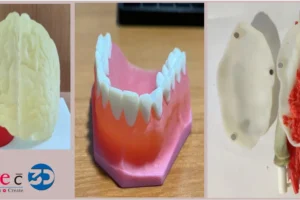The operating room is a place of precision and focus. Every step during surgery plays a crucial role in patient outcomes. 3D printing technology is emerging as a game-changer, offering surgeons a powerful tool: pre-planning models. These physical replicas of a patient’s anatomy, created using 3D printing, are revolutionizing surgery by enhancing efficiency and improving patient care.
Beyond 2D Scans: The Limitations of Traditional Planning Methods
Traditionally, surgeons rely on 2D scans like CT scans and X-rays for pre-operative planning. While valuable, these images have limitations:
- Limited Spatial Understanding: Flat images can make it challenging to visualize the 3D complexities of anatomy.
- Difficulties in Communication: Explaining complex procedures to patients using 2D scans can be challenging.
These limitations can lead to increased surgical time and potentially higher complication rates.
3D Printed Pre-Planning Models: A Tangible Advantage
3D printing offers a groundbreaking solution:
- Physical Representation: Pre-planning models provide a tangible, 3D replica of a patient’s anatomy, allowing surgeons to better visualize critical structures and plan their approach.
- Improved Communication: These models can be used to explain procedures to patients in a more clear and engaging way, fostering better understanding and informed consent.
- Enhanced Practice and Training: Surgeons can practice complex procedures on 3D models before operating on real patients, increasing confidence and reducing potential complications.

Unlocking the Benefits of 3D Printed Pre-Planning Models
The use of 3D printed pre-planning models offers a range of advantages for surgeons and patients:
- Reduced Surgical Time: Improved planning can lead to shorter surgeries, minimizing risks associated with anesthesia and blood loss.
- Increased Surgical Precision: A clearer understanding of anatomy can lead to more precise surgical maneuvers, potentially reducing complications.
- Improved Patient Outcomes: Faster surgeries, reduced complications, and better communication can all contribute to improved patient outcomes and faster recovery times.
Diverse Applications: 3D Printing Across Surgical Specialties
3D printed pre-planning models are finding applications in various surgical fields:
- Orthopedic Surgery: Models help surgeons visualize complex bone fractures and plan for implant placement.
- Neurosurgery: Detailed models of the brain allow for meticulous planning of tumor resections and other delicate procedures.
- Maxillofacial Surgery: Pre-printed models of the jaw and facial bones facilitate complex reconstructive surgeries.

The Future of 3D Printed Pre-Planning Models
The potential of 3D printed pre-planning models continues to expand:
- Integration with VR/AR: Combining models with virtual or augmented reality can create even more immersive planning experiences.
- Advanced Materials: Development of new materials that mimic the feel of real tissue is an ongoing area of research.
Revolutionizing Surgical Planning, One Model at a Time
3D printing technology is transforming surgical planning by offering surgeons a powerful tool – pre-planning models. These innovative models enhance visualization, communication, and surgical efficiency, ultimately leading to improved patient care and a brighter future in healthcare.
Ready to explore the world of 3D printed pre-planning models?
Search for terms like “3D printed models for orthopedic surgery” or “benefits of 3D printed models in neurosurgery” to discover how this technology is shaping the future of surgical planning.




